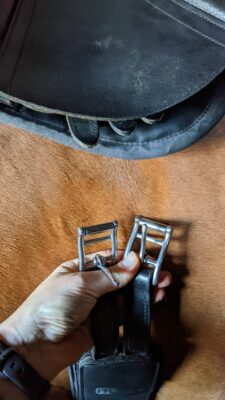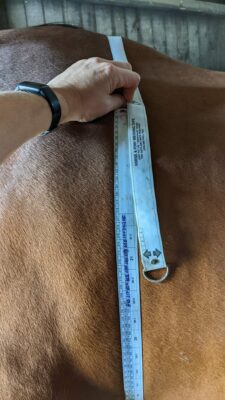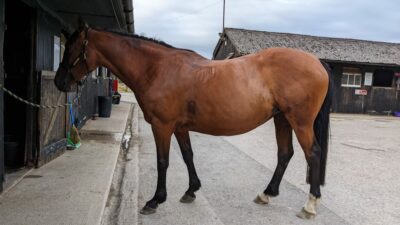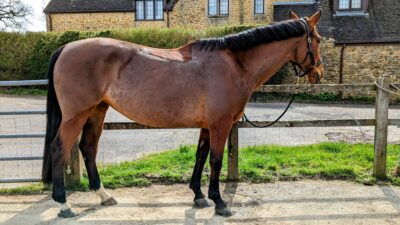Daily Management, Featured, Nutrition
Is my horse too fat?
Tamzin Furtado, discusses why horse owners struggle to recognise when their horses are fat
Most dog, cat, and horse owners are not very good at identifying whether their animal is carrying extra weight – this has been shown repeatedly in scientific trials however, it is more important with horses than other animals that they do maintain a healthy body condition. This is because horses unlike other companion animals, suffer from weight-related laminitis and, because we have such high expectations of them – we want to sit on them!
People find it difficult to identify when their animals are overweight for two main reasons – familiarity and love!
Familiarity – because we see our own animals all the time, it’s much harder to be spot subtle changes, like weight creeping on.
Love – when we love our animals it is really hard to be objective about them¹ ² ⁴. Studies have shown this with children; parents could identify overweight children accurately, but when shown a picture of their own child, were inaccurate³. So, you could be great at estimating condition in a friend’s horse but, that doesn’t mean you can be objective about your own – this is why it is vital to:
- use a system to condition score
- ask for objective opinions from professionals
 There is perhaps a third reason that people are sometimes bad at identifying weight issues in animals, and that’s down to cognitive bias – weight management has a reputation for being tricky, we may want to believe that our horses are a healthy weight so that we don’t need to change their management.
There is perhaps a third reason that people are sometimes bad at identifying weight issues in animals, and that’s down to cognitive bias – weight management has a reputation for being tricky, we may want to believe that our horses are a healthy weight so that we don’t need to change their management.
This is something we all need to be cautious about because if weight does creep on and our horses end up with laminitis, the management changes are much more extreme than they would have been, if we had managed them at an earlier stage.
Unfortunately, research shows that most owners are reactive about weight, rather than proactive; people wait until the horse is very fat and often actively laminitic, before making a change. By being more proactive and careful, we can protect our horse’s health, as well as our own stress levels and bank accounts.
Condition scoring
Most horse owners estimate their horse’s condition “by eye” ², which means just looking at the horse without any method to monitor weight change over time. But, this makes it even harder to observe changes over time, and even easier to become confused about what is fat, what is muscle, and what shape the horse is “meant to be”. In our study of equine weight gain, these were that factors that confused horse owners the most. 
Horses are particularly interesting to condition score compared to other animals, because they put on fat in places where muscle is seen as desirable: for example, the crest, over the back, and on the hindquarters. All these areas are the same places we like to build up in our working horses, which can be confusing for owners, for example whether a crest or a flat back (‘topline’ ) is due to muscle or fat. Even more concerning, some people sometimes actually like their horses to look fatter – they like to see that crest, or they perceive that a chunkier horse will be able to carry a heavier rider (unfortunately, the reality is the opposite; an overweight horse can actually carry less weight than a healthy weight horse).
Another issue is that we do have a lovely, diverse variety of horses and ponies in the UK – which includes our native ponies and cobs. In our study, owners of these breeds found it much harder to estimate their body condition, becoming easily confused by the shape they felt was “natural” for the horse.
Common examples of this would be owners thinking that all cobs have flat backs, invisible withers, and a crest. However, a useful rule of thumb is that unless a horse is in very hard work (for example, a high level of competition training), it is very unlikely that topline or a “big neck” are muscle as a result of training.
Additionally, with crests, it is quite easy to learn to find the nuchal ligament – the ligament that runs along the top of the neck. If there is any crest above this line, it can only be a result of fat; there is no muscle that can grow above here. A “big neck” which comes from training is then easily distinguishable because the muscle is visible on the horse’s neck below the nuchal ligaments.
The benefit of using an actual condition scoring scale rather than just looking at the horse by eye, is that a scale helps us to be more objective. Condition scoring scales consider the horse’s body in three sections: the neck and shoulder, the mid-section, and the hindquarters. Each section is evaluated separately, which allows us to view each horse as an individual; for example, some horses carry all their weight in their mid-section (like some humans!), while others may have almost-visible ribs, but a cresty neck and quarters.
Condition scoring horses allows us to compare the horse no matter their conformation and type, because it uses bony structures as markers (e.g. the ribs and pelvis), which should be easy to feel on all horses regardless of breed. Additionally, looking at the horse with an objective scale can help to identify often-missed fat pads, such as those behind the shoulder, or on the tailhead. It’s worth spending some time getting used to condition scoring different types of horses; it becomes very interesting once you get into it and can see how each horse carries their weight so differently.
Learn more about body condition scoring here
How can we be better at being objective about horse weight?
There are several, related options for this. Firstly, learning to condition score is quite straightforward and a valuable skill for every owner but, it does require a bit of time and thought; watch some YouTube videos, and then ask your vet or physio to make sure you’re being accurate in your assessments. Working with a friend will make you both learn to be even more objective.
Secondly, use actual measurements to monitor change over time and, to spot change in weight early on, before it becomes a problem: for example, using a weigh tape or weigh bridge, if you have access to one.
Thirdly, being aware of our own, and others’ bias is really important. We’re all human, and we all love our horses – that’s why we have them! But this means we do need to ask for help with being objective, and we also need to take on board the views of vets and other professionals who might tell us our horses need to lose some weight. I always suggest owners ask every professional who comes to the yard how the horse is looking – your farrier, physio, vet – Remember, they do not like telling you that there’s an issue, so if they do flag up a possible problem – pay attention and be proactive. Together, as a community, we can change the norms around obesity and protect all our horses from the harms of being overweight.
Related articles: The Dieting Horse
Further resources
https://www.thelaminitissite.org/articles/body-condition-scoring-video?view=full
https://www.beva.org.uk/Guidance-and-Resources/Routine-Healthcare/Equine-Obesity#weightmonitoring
https://www.beva.org.uk/Guidance-and-Resources/Routine-Healthcare/Equine-Obesity#weightmanagement
(Eli et al., 2014; Furtado et al., 2020; Royal College of Paediatrics and Child Health, 2015; White et al., 2011)
References
- Eli, K., Howell, K., Fisher, P. A., & Nowicka, P. (2014). “A little on the heavy side”: a qualitative analysis of parents’ and grandparents’ perceptions of preschoolers’ body weights. BMJ Open, 4(12), e006609. https://doi.org/10.1136/bmjopen-2014-006609
- Furtado, T., Perkins, E., Pinchbeck, G., McGowan, C., Watkins, F., & Christley, R. (2020). Exploring horse owners’ understanding of obese body condition and weight management in UK leisure horses. Equine Veterinary Journal, evj.13360. https://doi.org/10.1111/evj.13360
- Royal College of Paediatrics and Child Health. (2015). Tackling England’s childhood obesity crisis: A report by the Royal College of Paediatrics and Child Health to inform the development of the UK Government’s childhood obesity strategy (Issue October).
- White, G. A., Hobson-West, P., Cobb, K., Craigon, J., Hammond, R., & Millar, K. M. (2011). Canine obesity: is there a difference between veterinarian and owner perception? The Journal of Small Animal Practice, 52(12), 622–626. https://doi.org/10.1111/j.1748-5827.2011.01138.x



Pingback: How does being fat affect your horse? - The Horse Hub